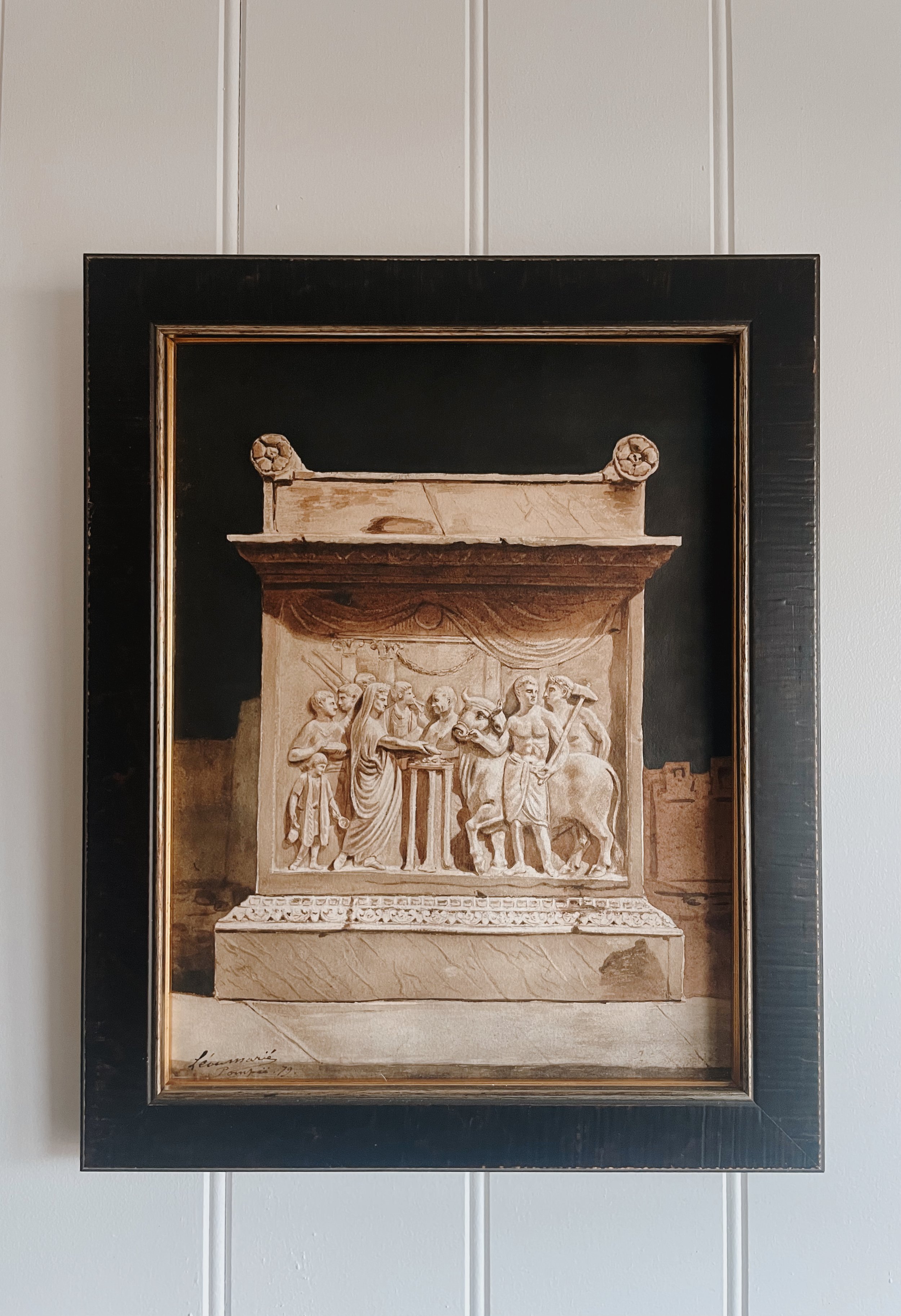Sacrificial altar to the Genius Augusti,
at the Temple of Augustus / Vespasian at Pompeii
By ‘Léonmarié’
Pompeii, 1879
Watercolour on paper
26 cm high x 32 cm wide
Signed & dated: ‘Léonmarié Pompeii. 79’
£5,000


This fine watercolour study depicts the ancient sacrificial altar to the Genius of Augustus, or Vespasian, in the Temple of Augustus / Vespasian at Pompeii. Excavated in 1817, in style, the altar is of the ‘Julio-Claudian’ type and constructed to worship the genius of Augustus, or Vespasian. It may have been built during the reign of Augustus (B.C. 27 – A.D. 14), and completed after the earthquake of A.D. 62, at the very end of the Julio-Claudian period (A.D. 14 – 68), or indeed during the reign of Vespasian (AD 69 – 79), at the start of the Flavian dynasty (A.D. 69 – A.D. 96). It follows many similar examples that have been found in temple courtyards across the roman empire.
L. R. Taylor wrote that: "The altar from Pompeii showing imperial emblems and the sacrifice of a bull, the regular victim offered to the genius, indicated the existence of an official municipal cult of the genius over which the priests of Augustus in Pompeii must have presided" (L. R. Taylor 1920. "The Worship of Augustus in Italy during his Lifetime." TAPA 51: 133). In the roman period, ‘Genius’ or ‘Genii’, were conceptualised as the personification of a (male) persons higher power, or spirit. It was essential for the creation and maintenance of life, assisting at the begetting and birth of every individual man and determining his character. It was believed that a man’s genius tried to influence his destiny for good, accompany him through life as his tutelary spirit, which would live on in the Lares after his death. They were worshipped and ‘indulged’ with festivities, for example, on the birthday of the head of a household.
On the western side of the altar there is a depiction of the ritual sacrifice of a bull, led by a priest who performs a ceremonial offering on a tripod aided by his assistants. Behind the priest are two lictors and a flute player, whilst in front stands an executioner, carrying an axe, who leads the bull to the sacrifice. In the scene there are also important depictions of roman youths. On the far left is a young female sacrificial assistant (knowns as a Camilla), who carries an a small pitcher (urceus) and a libation bowl shaped like a ladel (simpuvian). The style of her hair – tied back in a bun, is comparable to that worn by the figure of a young girl on the Ara Pacis frieze, Rome. However, Ryberg believed the youth to be a boy with a “girlish” hairstyle. The figure wears a cloth for the hands (mantele) around the neck. The presence of which suggests that the contents of the pitcher were water, as opposed to wine, and used for one of the libations or ritual washing of the priest’s hands. Another youthful figure in the background plays a double flute. Records suggest that flutes were played at sacrifices during the Roman royal period (753 - 509 BCE), either to announce the beginning of the ritual, or to be played throughout the ceremony. Writing in the third century A.D., Roman scholar Censorinus maintained that the purpose of flute players was to please the gods with their music.
The reliefs on the north and south sides depict the objects used in the cult's ceremonies: a curved staff, a box containing incense, a small tablecloth, a shallow dish for the libations, a pitcher and a ladle. The opposing eastern relief, facing the temple, consists of two laurel trees between which is hung a garland of oak leaves, the civic garland which, since Augustus, had been the symbol of imperial authority.
The Temple of the Genius Augusti at Pompeii is located between the Temple of the Lares Publici and the Building of Eumachia on the eastern side of the Forum. It was built upon the requests of Mamia, mentioned in an inscription as priestess of Cerere and of the Genius of Augustus. It adopted the same architectural design as the adjacent Portico of Concordia Augusta, and included a small courtyard, this altar and a small temple with four columns, accessible from both sides. The frieze was based on the model of the Ara Pacis in Rome.
